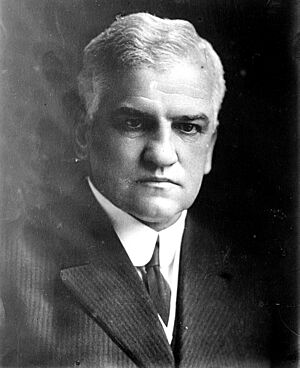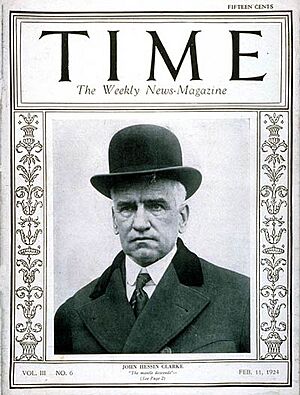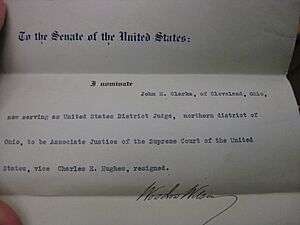John Hessin Clarke facts for kids
Quick facts for kids
John Hessin Clarke
|
|
|---|---|
 |
|
| Associate Justice of the Supreme Court of the United States | |
| In office October 9, 1916 – September 18, 1922 |
|
| Nominated by | Woodrow Wilson |
| Preceded by | Charles Evans Hughes |
| Succeeded by | George Sutherland |
| Judge of the United States District Court for the Northern District of Ohio | |
| In office July 21, 1914 – July 24, 1916 |
|
| Nominated by | Woodrow Wilson |
| Preceded by | William Day |
| Succeeded by | David Westenhaver |
| Personal details | |
| Born | September 18, 1857 New Lisbon, Ohio, U.S. (now Lisbon) |
| Died | March 22, 1945 (aged 87) San Diego, California, U.S. |
| Political party | Democratic |
| Education | Case Western Reserve University (BA) |
John Hessin Clarke (born September 18, 1857 – died March 22, 1945) was an American lawyer and judge. He served as a Supreme Court Justice from 1916 to 1922.
Contents
Early Life and Education
John Hessin Clarke was born in New Lisbon, Ohio. He was the youngest of three children and the only son. His father, John Clarke, was a Quaker immigrant from Ireland. He also became a lawyer and judge in the United States.
John H. Clarke went to New Lisbon High School. He then attended Western Reserve College. He graduated with honors in 1877. Clarke did not go to law school. Instead, he learned law by studying with his father. He passed his law exam in 1878 with excellent marks.
Starting a Career in Law and Politics
After practicing law in New Lisbon for two years, Clarke moved to Youngstown, Ohio. There, he bought half of a newspaper called the Youngstown Vindicator. This newspaper supported the Democratic Party. Clarke was a Democrat who wanted reforms. He wrote articles against big companies having too much power. He also supported ideas like making government jobs based on skill, not connections.
Clarke became involved in local politics. He tried to stop Calvin S. Brice from being nominated for the U.S. Senate in 1894, but he failed. However, he successfully worked against a Republican candidate for mayor of Youngstown. In 1896, Clarke disagreed with William Jennings Bryan becoming the Democratic presidential candidate. He even left the party for a short time to support another candidate.
Becoming a Progressive Politician
Soon after the 1896 election, Clarke moved to Cleveland, Ohio. He joined a law firm that worked for large companies and railroads. Clarke became very good at this work. He even became the main lawyer for the New York, Chicago and St. Louis Railroad.
But Clarke stayed involved in the Democratic Party. His political ideas changed over time. He started to support the new progressive movement. This movement wanted to solve social and political problems through government action. Clarke's friendship with Cleveland mayor Tom L. Johnson helped him regain his standing in the party.
In 1903, Clarke was nominated as the Democratic candidate for the U.S. Senate. Even though he was a good speaker, he lost the election. This was partly because he had worked for railroads and had not supported Bryan earlier.
After this defeat, Clarke focused more on his legal work. But he soon returned to politics. He supported adding progressive reforms to the Ohio Constitution in 1911. This helped him become popular again among Ohio progressives. He tried to run for the U.S. Senate again in 1914.
A Judge's Path
Serving as a Federal Judge
While campaigning for the Senate, President Woodrow Wilson appointed Clarke as a judge. This was for the U.S. District Court for the Northern District of Ohio. President Wilson and Attorney General James Clark McReynolds believed Clarke was a very capable lawyer. They thought he was the right person to handle many cases the court had. Wilson also hoped Clarke might become a Supreme Court Justice later.
Clarke was confirmed by the United States Senate on July 21, 1914. He quickly proved to be a very effective judge. He cleared up many backlogged cases. Lawyers respected his ability, even if they found him a bit formal. His work was excellent; only a few of his 662 cases were overturned. Clarke enjoyed his time as a district judge. He found the variety of cases interesting.
Becoming a Supreme Court Justice
In June 1916, a spot opened on the Supreme Court. Justice Charles Evans Hughes resigned to run for President. President Wilson wanted to appoint his Attorney General, Thomas W. Gregory. But Gregory suggested Clarke instead. After checking that Clarke was against large business trusts, Wilson offered him the job.
Clarke was not sure if he wanted to leave trial court work for the Supreme Court. But he felt he could not refuse such a great honor. He accepted the nomination. The Senate approved him unanimously ten days later. He officially became a Justice on October 9, 1916.
Clarke's time on the Supreme Court was not happy. He missed the freedom of being a trial judge. He disliked the long arguments and meetings. He also found it hard to agree with other justices when writing opinions. In his five years on the Court, he wrote 129 majority opinions. But he also disagreed with the majority 57 times.
He got along well with most justices. However, he had a difficult relationship with Justice James Clark McReynolds. This made him even more unhappy. McReynolds disliked Clarke so much that he refused to sign a letter of regret when Clarke resigned.
Philosophically, Clarke believed in legal realism. This idea suggests that judges should consider how laws affect real life. He often voted with Justices Oliver Wendell Holmes Jr. and Louis Brandeis. They often disagreed with the Court's more conservative majority. Clarke believed the government had the power to control the economy. He especially supported laws against child labor. He disagreed with rulings that limited Congress's power to address social problems like child labor. He also worked against monopolies, which are when one company controls an entire industry.
Why Justice Clarke Resigned
Clarke's time on the Supreme Court was short. On September 1, 1922, he told President Warren G. Harding he would resign. Several reasons led to his decision. He was unhappy with his work as a Justice. His problems with Justice McReynolds continued. Also, his sisters had recently passed away. He also saw how Chief Justice Edward Douglass White declined physically while on the bench. Clarke wanted to avoid a similar situation. He had few regrets about leaving. He even told his replacement, George Sutherland, that being a Justice was "a dog's life."
Later Years and Public Service

Working for the League of Nations
After resigning, Clarke announced a new goal. He wanted to convince Americans that the United States should join the League of Nations. This was an international organization created after World War I to promote peace. At the time, many Americans did not want to join.
In October 1922, Clarke became president of a new group. It was called the League of Nations Non-Partisan Association. This group wanted to show that many Americans actually supported joining the League. Clarke quickly became a leader in this effort. He traveled and gave many speeches.
However, Clarke faced challenges. The Association spent a lot of money. Also, Clarke realized that there was not as much support for the League as he thought. Many Americans were still unsure or against the idea. Clarke and the group had to change their plans. They focused on getting the U.S. to join the World Court. Clarke continued to work for American involvement in international groups for the rest of the decade.
Retirement and Final Years
By late 1927, Clarke's hearing was getting worse. He was also frustrated that the Association had not fully succeeded. He resigned from its presidency. In retirement, Clarke remained active. He enjoyed reading and traveling. He also continued to serve the public. He became a trustee for Western Reserve University, his old college.
In 1932, he quietly supported Newton Baker for president. After Baker lost, Clarke became a supporter of President Franklin D. Roosevelt and his New Deal programs. These programs aimed to help the country recover from the Great Depression. In 1937, Clarke even defended Roosevelt's plan to change the Supreme Court.
In 1931, Clarke moved from Cleveland to San Diego, California. He lived in the El Cortez Apartment Hotel. He died there from a heart attack on March 22, 1945. His alma mater, Case Western Reserve University, honored him by naming a residence hall, Clarke Tower, after him.
See also
- List of justices of the Supreme Court of the United States


